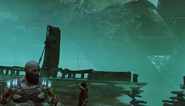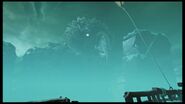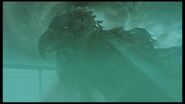Template:Location Infobox
- "It is a land of unyielding cold. Fires cannot burn there, and no magic in all the Nine Realms can create a blaze. As for the dead... your frost axe will be useless."
- ―Freya
Helheim, also known as Hel, is one of the Nine Realms of the World Tree, the final destination of the dishonorable dead and a major location in God of War.
Norse Mythology
In Norse mythology, Hel, the location, shares a name with Hel, a being who rules over the location. In late sources, varying descriptions of Hel are given and various figures are described as being buried with items that will facilitate their journey to Hel after their death. In the Poetic Edda, Brynhildr's trip to Hel after her death is described and Odin, while alive, also visits Hel upon his horse Sleipnir. In Snorri Sturluson's Prose Edda, Baldur goes to Hel on his death and subsequently Hermóðr uses Sleipnir to attempt to retrieve him.
History
God of War (2018)
The Realm of the Dead is a land of darkness and unyielding cold, the extreme temperatures being so lethal that even Odin himself is unable to survive for long.
Those who die as criminals, of disease, mishap and age end up spending eternity in the City of Helheim, a place where there are forever tormented by visions of their past.
The realm possesses dark clouds covering the skies, an emerald-colored thin fog, mountains of ice, structures of stone and human-shaped metal statues.
An everpresent wind current, known as the Winds of Hel, always blows throughout the entire realm. There are spherical devices that can hold the winds, usually used as door locks.
Despite the overwhelming cold and abundant ice, there are non-frozen rivers of water that flow from waterfalls where Týr's Temple is located. A ship docked in the City of Helheim can be used to traverse the rivers.
Helheim's architecture consists of bridges, gates and buildings made of stone, most which are covered by thick layers of ice and snow. Most of their metal statues scattered throughout the realm depict humans in lament states, and others hold wind-retaining spheres in their hands.
The souls of the deceased must pass through the Bridge of the Damned to reach the City of Helheim, a bridge which is guarded by the Bridge Keeper Máttugr Helson, a native Troll of Helheim.
In the city itself is where the residents are usually tormented by visions created by the emerald fog taking shape. In the city's highest building is also where laids an enormous silver eagle who simply gazes the Dead Realm.
In a sealed Hidden Chamber of Odin is where the Valkyrie Ròta was imprisoned.
Also, because of the Valkyries' recent imprisonment, those who die in battle can't reach Valhalla, thus the Realm of the Dead is overwhelmed and the City of Helheim is overpopulated, forcing many dead to return to the realms of the living as Hel-Walkers.
By the time Kratos and Atreus begin their journey, Midgard is already being infested with Hel-Walkers.
It was when Atreus fell ill that Kratos, alongside Mimir, ventured towards the realm of the dead to retrieve Mattugr Helson's heart to cure his son, an endeavor that resulted in Helheim losing its Bridge Keeper.
Kratos returned to Helheim alongside Atreus and Baldur when the latter attempted to take the child to Asgard. Kratos interrupted the transportation sequence of Týr's Temple which forced them to go to Helheim instead.
In Helheim is where Kratos and Atreus found out that Baldur was the son of Freya, and Atreus got a glimpse of his father killing his grandfather.
The three would later return to Helheim to free the corrupted Valkyrie Rota from her imprisonment.
Leaders
The current leaders of Helheim, if there are any, are currently unknown.
Regions
- Bridge of the Damned
- City of Helheim
- Helheim Landing
- Skies of Helheim
Gallery
Trivia
- Helheim is ruled by the goddess of death, Hel, who is the daughter of Loki. Seeing as how Loki (Atreus) is still a child in this game, it's possible that Hel hasn't been born yet.
- Interestingly, at least one of her brothers, Jörmungandr, is alive at the time.
- It's possible that the giant eagle that gazes Helheim is Hræsvelgr/Hraesvelg (Old Norse "Corpse Swallower"), a Jötunn who takes the form of a bird and sits at the edge of the world overlooking Helheim and makes the wind blow with the flapping of his wings.
- Players get a much closer look at the eagle when Kratos and Atreus air-sail next to it.
- Mimir states that time moves much slower in Helheim than it does in Midgard.
- Kratos wondered why its dishonorable to grow old, but Mimir couldn't give him a clear answer. The ancient Nordic culture believed that it was better to go out fighting.
- Though the cold and wind are so great within Helheim that no fire of any kind in the Nine Realms can stay alight, fire from foreign realms can remain burning. This includes the fire from Kratos's original weapons, the Blades of Chaos.
- Thus, such fire is very effective and deadly to the denizens of Helheim.
- This could be considered a direct contrast to the Greco-Roman Underworld which was often seen as a heavily volcanic area.
- Helheim doesn't make differences between the criminals its meant to torture and everyone else, thus the ones who died of sickness, age, and even the living ones that visit Helheim are haunted by visions of their past.
- Towards Kratos, it was visions of Zeus who called to him, and even depicted a ghostly reenactment of his death.
- Towards Baldur, it was a vision of when he confronted Freya, his mother, and tried to make her lift his curse of not being able to feel.
- Towards Atreus, it was a vision of his recent cruelty against Modi.
- Helheim continues the tradition in the God of War series for Kratos to visit the land of the dead; in the Greek Era Kratos explored or was sent to the Underworld numerous times as well as exploring Thanatos' realm when searching for his brother.
- With the possible exception of Baldur, Magni, and Modi, it is likely that most, if not all of the characters fought and killed within the game ended up in Helheim.
- Interestingly, in Norse mythology, Baldur did in fact end up in Helheim after his death. Whether or not this holds true in the games' continuity is currently unknown.
- The rune for Helheim is Hagalaz, which among other things, represents hail.
- Its Greek-Roman equivalent is the Underworld.



